AT40 = 17.3% of stocks are trading above their respective 40-day moving averages (DMAs) – 10th day of oversold period following 4-day oversold period
AT200 = 29.5% of stocks are trading above their respective 200DMAs
VIX = 23.4
Short-term Trading Call: bullish
Commentary
The small bullish divergence to start the week received follow-through in the form of a big rally day in the stock market. AT40 (T2108), the percentage of stocks trading above their respective 40-day moving averages (DMAs), jumped from 11.9% to 17.3%. Suddenly, it looks possible for the stock market to bring an end this week to this extremely extended oversold period (AT40 above 20%). AT200 (T2107), the percentage of stocks trading above their respective 200DMAs, came to life by hopping from 25.4% to 29.5%. AT200 even slightly broke through its steep downtrend.
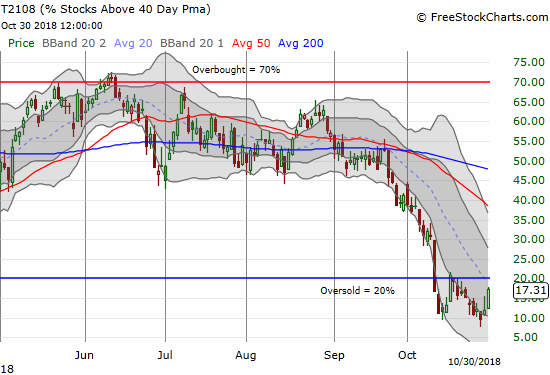
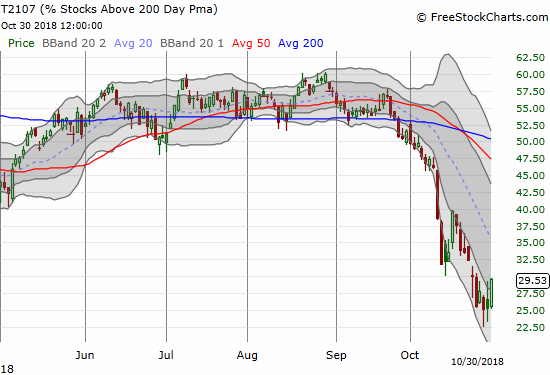
So far, the S&P 500 (SPY) is down 4.5% for this 10-day old oversold period. The index is down 3.7% from the start of the first oversold period which is only separated from the current period by one trading day. If the oversold period had ended today, the S&P 500’s performance would have been in-line with historic 14-day long oversold periods and under-performed historic 10-day oversold periods. In both cases projections are for less weakness.
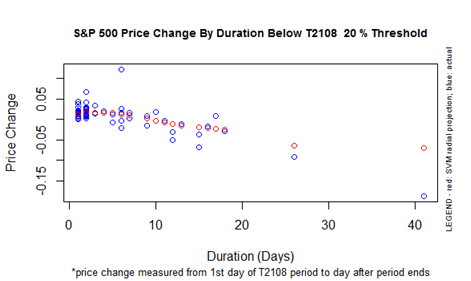
In other words, there is a decent case to be made that the breakout from this oversold period will come with another big rally day for the S&P 500. It will need to be a big move to break out of the current steep downward trading channel formed by the lower Bollinger Bands (BBs).
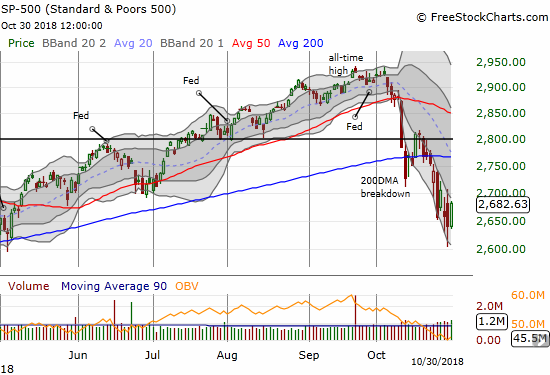
The NASDAQ gained the same percentage as the S&P 500 but its range of motion was not nearly enough to nullify the previous day’s fade and selling. The Invesco QQQ Trust (QQQ) gained 1.7% but also failed to nullify the previous day’s pressure.
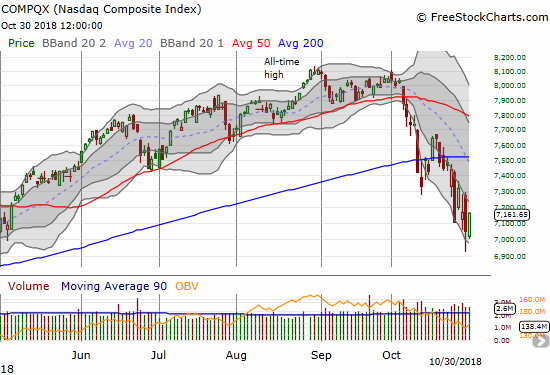
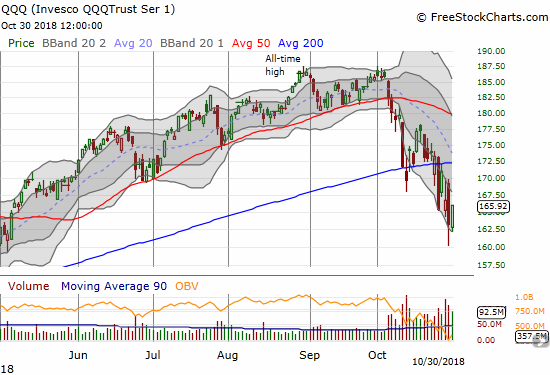
The volatility index, the VIX, only fell 5.5% and closed at 23.4. It is still at elevated levels (above 20) so the stock market remains very vulnerable to wide swings and sharp selling, but at least the intraday high did not reach the recent highs.
The iShares Russell 2000 ETF (IWM) rallied for a 2.1% gain. Unlike the other major indices, IWM managed to tap the upper bound of its downward trading channel. IWM hugged this line in the selling that led to the current levels. Follow-through buying would represent a very important breakout.

Although I did not get the volatility spike I wanted to trigger more aggressiveness, I still treated the rally as a validation of the bullish signs from the previous day. I focused on my shopping list even as I took my profits on my latest tranche of SPY call options (expiring Friday). I loaded up on CSX Corporation (CSX) calls, a calendar call spread on Intel (INTC), and of course I implemented my Facebook (FB) pre-earnings trade (twice!). I also decided to get aggressive with small caps given the abundance of beaten up small caps I saw with big gains on the day. I started accumulating call options on IWM expiring in 2 1/2 weeks. I capped off my hedges with a put spread on Boeing (BA) which rallied right to its 200DMA and an obligatory put option on Caterpillar (CAT). From here, I can stay 100% focused on the bullish buying opportunities…while of course keeping in my peripheral vision the on-going (technical) market risks that I have covered in previous Above the 40 posts.
CHART REVIEWS
Equifax Inc. (EFX)
I lost track of EFX in the market sell-off. This is a stock I would have shorted upon the FIRST break of its 200DMA. The second 200DMA breakdown would have been my confirmation. Instead, I can only watch as I see the bearish weight reassert itself on EFX. At its post-earnings intraday low, EFX traded right at the close that marks its post data breach low.
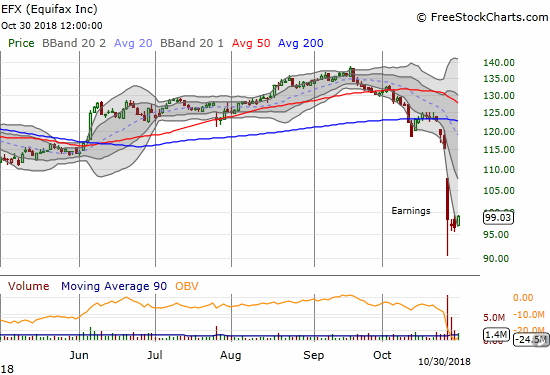
General Electric (GE)
Both the fundamentals and the technicals failed to identify a sustainable bottom in GE. Now I just throw up my hands. Times like these remind me of the loss-limiting benefits of playing options instead of shares for such a high-risk play.

International Business Machines (IBM)
IBM is clearly desperate to arrest its stubbornly persistent downward momentum. The company offered a massive premium to buy Red Hat (RHT) in a cash deal valuing RHT at $190/share (and yes, I did happen to get back into the stock ahead of this news. I closed out the position of course). IBM’s stock understandably dipped Monday on the news. However, today’s resumption of selling surprised me. IBM lost 3.5% and finally broke down below its 2016 low. IBM last saw these prices way back in July, 2009! If the mega-deal for RHT cannot rejuvenate the stock, what can?
In the meantime, RHT is still trading at a discount to the deal’s value. On Monday, RHT fell as low as $166. Today it closed up slightly to $170. Options players are just as skeptical. The June 2019 $180 call option sells for around $4.50. I would have expected it to trade at least at $8.00. I want to buy RHT call options, and now I am wondering whether there is a pairs trade opportunity with IBM…I just do not know whether the paired position should be long or short!
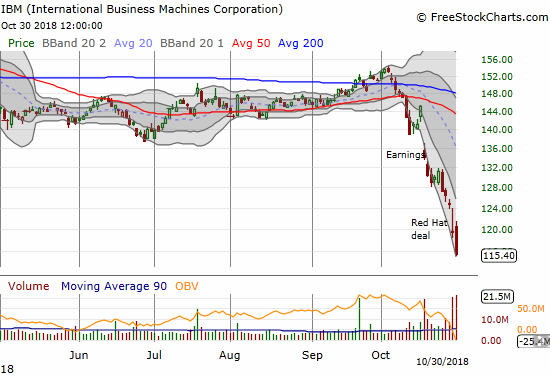
Intel (INTC)
I do not like to chase, but I also do not want INTC to get away from me coming off a good response to it earnings report. On Monday, INTC almost closed its post-earnings gap, and I failed to get my between earnings trade started. Today, the stock suddenly soared 5.2%. At a 4% gain on the day, I decided to jump in with a “starter” position using a Nov/Jan $48 calendar spread. I am targeting 200DMA resistance to hold for the next two weeks on INTC. If INTC dips back to or around its 50DMA, I will start loading up on calls straight up.
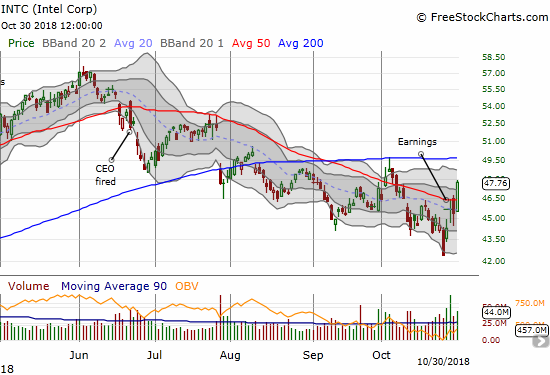
Logitech (LOGI)
I periodically check in on LOGI for a new entrypoint for buying. The stock’s post-earnings low wiped out all the stock’s gain for 2018. I like accumulating shares after the stock prints a post-earnings closing high which should, hopefully, signify the return of buyers to the stock.
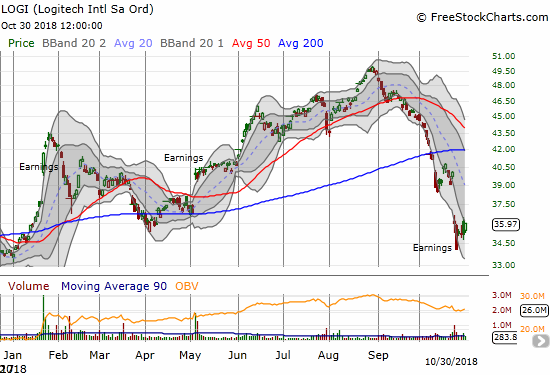
Netflix (NFLX)
NFLX demonstrated yet more relative weakness. The stock gapped down at the open and had to claw its way back to a mere 0.3% gain. The intraday low matched with the intraday lows from April.
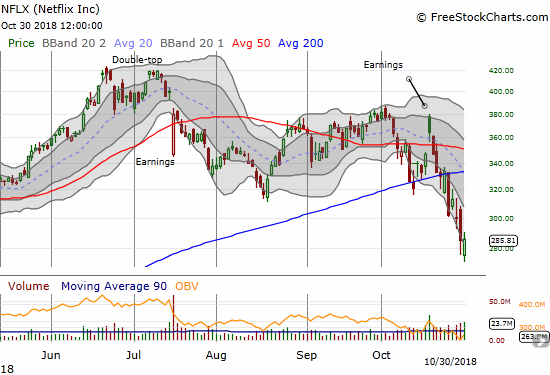
Walmart (WMT)
WMT is one of the last stocks I could imagine going (near) parabolic. Yet, here it is surging for a 2.6% gain and closing well above its upper Bollinger Band after announcing a package of new technologies and services in advance of the holiday shopping season. WMT has taken off in the middle of a vicious market sell-off. The stock bounced nearly straight off its 50DMA support in an impressive display of relative strength as the rest of the stock market just kept sinking. With the stock finally printing a new post-earnings high, WMT is positioned to challenge its all-time high. I imagine the stock will need a “rest” soon to fuel up for the next charge higher.

— – —
FOLLOW Dr. Duru’s commentary on financial markets via email, StockTwits, Twitter, and even Instagram!
“Above the 40” uses the percentage of stocks trading above their respective 40-day moving averages (DMAs) to assess the technical health of the stock market and to identify extremes in market sentiment that are likely to reverse. Abbreviated as AT40, Above the 40 is an alternative label for “T2108” which was created by Worden. Learn more about T2108 on my T2108 Resource Page. AT200, or T2107, measures the percentage of stocks trading above their respective 200DMAs.
Active AT40 (T2108) periods: Day #10 under 20% (oversold), Day #15 under 30%, Day #22 under 40%, Day #27 under 50%, Day #43 under 60%, Day #96 under 70%
Daily AT40 (T2108)

Black line: AT40 (T2108) (% measured on the right)
Red line: Overbought threshold (70%); Blue line: Oversold threshold (20%)
Weekly AT40 (T2108)

*All charts created using freestockcharts.com unless otherwise stated
The charts above are my LATEST updates independent of the date of this given AT40 post. For my latest AT40 post click here.
Related links:
The AT40 (T2108) Resource Page
You can follow real-time T2108 commentary on twitter using the #T2108 or #AT40 hashtags. T2108-related trades and other trades are occasionally posted on twitter using the #120trade hashtag.
Be careful out there!
Full disclosure: long UVXY puts, other positions already referenced
*Charting notes: FreeStockCharts.com stock prices are not adjusted for dividends. TradingView.com charts for currencies use Tokyo time as the start of the forex trading day. FreeStockCharts.com currency charts are based on Eastern U.S. time to define the trading day.
